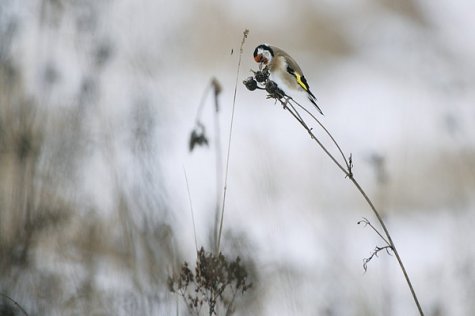Colourful winter birds
Photo: Arne Ader
Translation: Liis
Goldfinch
Goldfinch Ohakalind Carduelis carduelis
The seed-eating goldfinches often search on weedy areas for their bellyful from thistles, burdock and cruciferous plants. Moving around in cultural landscapes they are busy in hedges on farm lands, parks, broadleaf tree stands …
The passage of migrants heading towards south ends in November; they migrate in daytime. Brave winterers even stay with us, around some ten thousand individuals. Goldfinches are sociable, when searching for food they move around in small groups, where the differences between individuals easily can be compared. The body length is more than twelve centimetres and the weight between fifteen to twenty grams.
Goldfinches have bright colours enough and to spare: the head plumage of adults is patterned in red-black-white, back plumage is yellowish brown as the sides of the chest. The slightly larger male birds have a little more red in the head plumage and the yellow band on the black wings seems a little wider and brighter; the plumage of females is a little duller. The tail of the goldfinches is markedly deeply incised, and both tail and wing feather tips have white patches. The beak of the brown-eyed birds is reddish-grey, with a dark tip, legs brown.
Young birds are easy to recognize in a group – they have a greyish-brown patterned plumage, head yellowish-brown, on the wings however we already see yellow feathers.
When keeping caged birds still was fashionable, the colourful goldfinches were caught in large numbers for this purpose. Male goldfinches were caged together with female canary birds in order to get beautiful and well singing cage birds...
Observations of goldfinches: LINK









